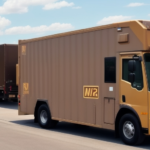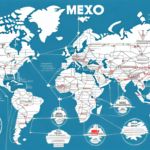Understanding UPS Shipping International Rates
UPS is a leading shipping service provider that offers both domestic and international shipping solutions. For businesses shipping internationally, understanding UPS shipping rates, fees, and additional costs is crucial. This article delves into everything you need to know about UPS shipping international rates—including their importance, calculation methods, and strategies to save money.
Why are UPS Shipping International Rates Important?
International shipping presents several challenges, such as customs duties and taxes, additional fees, and destination-specific restrictions. Understanding UPS shipping international rates is essential for businesses to avoid overpaying and to effectively budget for shipping costs. According to UPS’s 2023 annual report, international shipping costs account for approximately 35% of their total revenue, highlighting the significance of these rates for both UPS and its customers.
Moreover, UPS shipping international rates vary based on the weight, size, and destination of packages. A clear understanding of these factors helps businesses prevent unexpected costs and delays. By being knowledgeable about UPS rates, businesses can also compare prices with other shipping carriers and select the most cost-effective option, enabling global expansion while maintaining shipping cost control.
Factors that Affect UPS Shipping International Rates
The cost of international shipping with UPS is influenced by several factors:
- Weight and Size: Larger and heavier packages incur higher shipping costs.
- Destination Country: Shipping rates vary significantly depending on the destination’s distance and region.
- Shipping Speed: Faster shipping options, such as express services, are more expensive.
- Value of Goods: Higher value items may require additional insurance, increasing costs.
- Mode of Transportation: Choices between air, ground, and ocean freight affect pricing.
- Additional Fees: Customs clearance, brokerage charges, and other surcharges can add to the total cost.
Understanding these factors is vital to accurately estimate shipping costs and optimize overall shipping strategy. For detailed information on UPS international shipping rates, refer to the official UPS International Services page.
How to Calculate UPS Shipping International Rates
Calculating UPS shipping costs involves several key pieces of information:
- Origin and Destination: The starting point and destination country of the shipment.
- Weight and Dimensions: The total weight and size of the package.
- Shipping Date: The planned date for shipment.
- Shipping Method: Choices include express, standard, and economy services.
You can use the UPS shipping calculator to obtain an estimate. For more precise quotations, it’s advisable to contact a UPS representative. Keep in mind that rates may fluctuate based on seasonal demand and additional fees.
UPS offers various international shipping options, such as:
- UPS Worldwide Express: Fastest delivery option.
- UPS Worldwide Expedited: Balances speed and cost.
- UPS Worldwide Saver: Cost-effective with reasonable delivery times.
Additionally, UPS provides customs clearance services to ensure compliance with international shipping regulations. Proper calculation and selection of shipping methods are essential for cost-effective and timely deliveries.
Comparing UPS Shipping International Rates with Other Carriers
When selecting a shipping carrier, comparing UPS rates with other providers like FedEx and DHL is beneficial. Each carrier has its own pricing structure, additional fees, and service levels. For example, FedEx might offer quicker delivery times on certain routes, while DHL may provide better rates for specific international regions.
Key factors to consider when comparing carriers include:
- Rates and Additional Fees: Evaluate base rates and any extra charges.
- Delivery Time: Assess if the carrier meets your required delivery schedules.
- Customer Service: Consider the level of support and reliability the carrier offers.
UPS is renowned for its excellent customer service and extensive global network, making it a reliable choice for international shipping. However, the best choice depends on specific business needs and shipping patterns.
Tips on How to Save Money on UPS Shipping International Rates
Businesses can implement several strategies to reduce UPS international shipping costs:
- Negotiate Rates: If you ship large volumes regularly, negotiate discounted rates directly with UPS.
- Choose Slower Shipping: Opting for economy or standard services can significantly lower costs.
- Optimize Packaging: Use efficient packaging to minimize weight and dimensions, reducing shipping costs.
- Leverage Third-Party Logistics Providers: 3PLs often have negotiated rates and can provide cost-saving insights.
- Utilize UPS Online Tools: Tools like the UPS shipping calculator help compare rates and choose the most economical options.
Additionally, ensuring proper classification of goods and accurate documentation can prevent delays and avoid unexpected fees associated with customs duties and taxes.
Understanding Surcharges and Additional Fees on UPS Shipping International Rates
Various surcharges and additional fees can increase the total cost of international shipping with UPS:
- Fuel Surcharges: Reflect fluctuations in fuel prices.
- Delivery Area Surcharges: Applied to remote or less accessible destinations.
- Customs Clearance Fees: Costs associated with processing shipments through customs.
- Brokerage Charges: Fees for managing customs brokerage services.
The applicability and amount of these surcharges depend on the destination country and the specific details of the shipment. For instance, shipping hazardous materials or oversized packages can incur additional fees. Always review the UPS Surcharges and Fees page to understand potential additional costs before finalizing your shipment.
How to Negotiate Better UPS Shipping International Rates for Your Business
Businesses shipping large volumes internationally can negotiate better UPS shipping rates through:
- Contract Agreements: Establish long-term contracts with UPS to secure discounted rates.
- Leveraging Third-Party Logistics Providers: 3PLs can negotiate favorable rates on your behalf due to their established relationships with carriers.
- Optimizing Shipping Practices: Consolidate shipments and choose cost-effective shipping options to reduce overall costs.
Engaging directly with UPS representatives and regularly reviewing shipping practices can lead to significant cost savings and more favorable rate agreements.
Common Mistakes to Avoid When Dealing with UPS Shipping International Rates
To ensure cost-effective and smooth international shipments with UPS, avoid the following common mistakes:
- Incorrect Declaring of Goods Value: Underreporting or overreporting can lead to unexpected taxes and duties. Always declare accurate values.
- Ignoring Destination Regulations: Each country has specific import/export regulations. Failing to comply can result in delays or returned packages.
- Poor Packaging: Inadequate packaging can lead to damaged goods, incurring additional costs and customer dissatisfaction.
Thorough research and adherence to international shipping guidelines are essential to avoid these pitfalls.
The Impact of Taxes and Customs Duties on UPS Shipping International Rates
Taxes and customs duties significantly influence the total cost of international shipping. These charges vary by country and depend on the type and value of the goods being shipped. Understanding the import/export regulations of the destination country is crucial. UPS provides tools to estimate these costs, ensuring businesses can factor them into their budgeting and pricing strategies.
How to Track Your Package and Monitor Its Progress During International Shipping with UPS
UPS offers a comprehensive tracking service that allows businesses to monitor the progress of their international shipments in real-time. This service provides detailed updates at various checkpoints, helping predict delivery times and keep customers informed. Utilizing UPS tracking enhances transparency and can improve customer satisfaction by providing timely updates on their orders.
Understanding the Insurance Options for Your Package with UPS During International Shipping
Protecting your shipments is vital, especially when shipping internationally. UPS offers several insurance options to safeguard against lost or damaged packages:
- Standard Liability: Covers a limited value of the package.
- Declared Value: Allows businesses to declare the package’s value up to a specified limit, providing additional coverage.
- Additional Insurance: For high-value items, businesses can purchase extra insurance to ensure full coverage.
Choosing the appropriate insurance option based on the shipment’s value and importance can provide peace of mind and financial protection.
Benefits of Using a Third-Party Logistics Provider for Your Business's UPS Shipping Needs
Third-party logistics providers (3PLs) offer numerous advantages for businesses handling international UPS shipping:
- Discounted Shipping Rates: Through their volume-based negotiations, 3PLs can secure lower shipping rates.
- Expertise: 3PLs are well-versed in international shipping regulations and customs requirements, reducing the risk of non-compliance.
- Efficiency: They optimize supply chains, streamline shipping processes, and improve overall shipping efficiency.
Partnering with a reputable 3PL can lead to cost savings, enhanced shipping reliability, and better focus on core business activities.
Case Studies: Real-life Examples of How Businesses Have Optimized Their UPS Shipping International Rates
Numerous businesses have successfully optimized their UPS international shipping rates through innovative strategies:
- Packaging Optimization: A retail company reduced package dimensions by redesigning packaging, resulting in lower shipping costs and more efficient storage.
- Rate Negotiation: A wholesale distributor negotiated bulk shipping rates with UPS, significantly decreasing their per-shipment costs.
- Shipment Consolidation: An e-commerce business consolidated multiple shipments into a single package, reducing the number of shipments and overall costs.
These examples demonstrate how strategic adjustments in shipping practices can lead to substantial cost reductions while maintaining service quality.
Frequently Asked Questions About UPS Shipping International Rates
Here are some frequently asked questions regarding UPS shipping international rates:
- What is the cheapest international shipping method with UPS?
- What is the fastest international shipping method with UPS?
- How much does it cost to ship internationally with UPS?
- What surcharges and additional fees may apply with UPS shipping international rates?
- How to deal with customs duties and taxes when shipping internationally with UPS?
- How to monitor and track my package during international shipping with UPS?
- What is the maximum value that can be declared for packages shipped internationally with UPS?
- What are some tips for negotiating better UPS shipping international rates?
Understanding UPS shipping international rates can be complex, but with the right knowledge and strategies, businesses can avoid overpaying and ensure efficient global shipping operations. By following the guidelines outlined above and utilizing available resources, businesses can optimize their international shipping processes and achieve long-term cost savings.






















